Take Care When Exercising Not to Overstress Your Body
Whether it’s tennis, swimming, backyard baseball or cricket, cycling, bushwalking or just doing more gardening, everyone feels like exercising when the weather is warm. But while enthusiasm is great, knowing how to avoid injury is even more important.
Baby Boomers (aged between 45 and 64) are known for their ‘forever young’ attitude, but orthopaedic surgeons and exercise experts suggest middle-aged people should take a more cautious approach and remember that their bodies aren’t as resilient as they once were.
“Baby boomers have become increasingly active as they age and orthopaedic surgeons think this trend will continue,” says Dr Ray Monto of the American Academy of Orthopaedic Surgeons (AAOS). “One thing to keep in mind is that when you are 50, you may injure your body more easily than when you were 20.”
In 2008, more than 166,000 people between the ages of 45 and 64 were treated in emergency rooms, clinics, and doctors’ offices for injuries related to exercise and exercise equipment. Preventing these types of injuries starts with proper warm-ups, gradual intensity increases, and informed training choices.
Exercise Benefits Everyone Over 40
“Exercise is always beneficial for older people and in fact for people of any age, but especially after 40,” says Dr Tim Henwood, postdoctoral research fellow at the University of Queensland, who specialises in exercise and older adults.
Regular activity after 40 can improve cardiovascular health, mobility, and muscle tone while helping to prevent chronic diseases. As covered in our article on how exercise helps you beat depression, movement isn’t just good for the body—it’s essential for mental well-being too.
Medical research also shows that people over 40 who exercise consistently are less likely to experience weight gain, diabetes, high blood pressure and sleep disturbances. “Everybody, no matter what their age, should be trying to get a well-rounded activity program,” Dr Henwood advises.
“Ideally, individuals should do something that raises their heart rate three days per week, punctuated with a minimum of two days per week challenging their muscles,” he adds. This aligns with fitness guidelines for men aiming to stay active and strong throughout midlife and beyond.
Don’t Overstress Your Body While Exercising
The problem, Henwood says, is that “individuals are jumping in too quick and ending up injured.” Joints, tissues, and muscles may not be as flexible as they used to be, and recovery takes longer with age. Both doctors recommend that older adults take extra precautions to protect themselves from injuries.
“A little extra stretching before and after exercise goes a long way,” Dr Monto advises. Dynamic and static stretches like those shown in stretches for muscle flexibility and growth can reduce stiffness and improve mobility when done regularly.
Dr Henwood also reminds exercisers that “we are a little more susceptible to injury as we age, we fatigue quicker and require greater recovery time frames.” The best approach? Start slow, set realistic goals, and consult an expert when in doubt.
Tips to Avoid Injuries While Exercising
- Check with your doctor before beginning any new exercise program, especially if you’ve had a previous injury or health condition.
- Always warm up and stretch before exercising. Cold muscles are more prone to tears or sprains.
- Avoid being a “weekend warrior.” Moderate, consistent exercise is safer than sudden bursts of intensity.
- Take lessons. A qualified instructor can help you master form and prevent overuse injuries like tendonitis or stress fractures.
- Develop a balanced fitness program that combines cardio, strength training, and flexibility work.
- Introduce new exercises gradually to avoid overloading your joints and tendons.
- Listen to your body—pain and fatigue are warning signs, not challenges to push through.
- Schedule rest days. Recovery is when your body grows stronger.
For additional guidance on safe physical activity at any age, refer to the CDC’s Physical Activity Guidelines for Older Adults, which provide medically backed recommendations for maintaining fitness safely.


